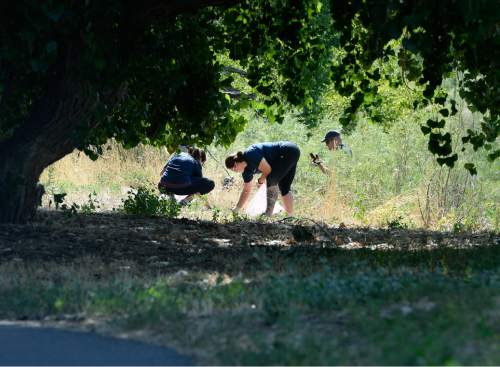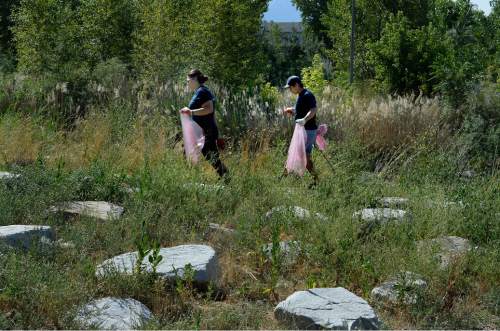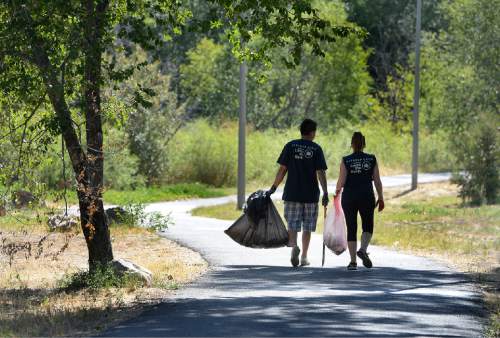This is an archived article that was published on sltrib.com in 2015, and information in the article may be outdated. It is provided only for personal research purposes and may not be reprinted.
Seems like Utah has been here before.
As the latest and largest installment of the Outdoor Retailer show comes together this week in the heart of Salt Lake City, organizers say they are again weighing whether to move the coveted convention, which pumps $40 million into the area's economy.
This time around, four other cities are in contention — Las Vegas, Chicago, Dallas and Orlando, Fla. — for the lucrative trade show. And, again, Utah's conservative public-lands agenda is being blamed for the Outdoor Industry Association's second thoughts about traveling to Salt Lake City every year.
The 4,000 businesses that are members of the association depend on unspoiled public lands where their customers use skis, tents, packs, climbing gear, kayaks, footwear, apparel and the other equipment they make — activities that support an industry that generates $646 billion a year in consumer spending across the nation.
Those assets preserved for all Americans could be under assault if Utah prevails in its quest to take over thousands of routes and 30 million acres of public lands, industry leaders warn.
"There is growing frustration that some of the most egregious, radical, damaging policies in the country relative to public lands and outdoor recreation are being germinated and cultivated in Utah and supported by public policy here," said industry pioneer Peter Metcalf, the Black Diamond Equipment executive who helped lure the show to Salt Lake City in the mid-1990s.
"There is lip service to outdoor industry, for sure, but the policies are absolutely antithetical to the values and beliefs of the industry."
While the masterminds behind Utah's public-lands campaign dismiss the debate as so much environmental chatter, some worry that, after 20 years in Salt Lake City and ever-growing demands for more convention and hotel space, the twice-annual shows could really move this time.
A looming decision • The Outdoor Industry Association (OIA) doesn't decide where the show is held, but its members wield influence. Show owner Emerald Expositions has surveyed its exhibitors, who are largely OIA members, about their feelings on the show's future.
"We got a large response rate. We are poring through that," said Emerald spokeswoman Kate Lowery. "It is a large ecosystem within our industry."
She expects Emerald will announce the future venue soon after this week's summer show concludes.
Metcalf acknowledges a complex set of issues goes into such a decision and Salt Lake City still holds strong cards, including convenient access to a major airport and mountains, along with a vastly improved public transportation system and downtown dining and night life.
Emerald recently unveiled a short list of candidate cities to host the show after its contracts with the Salt Palace Convention Center expire next year. They span the country — from Nevada to Florida. None of Salt Lake City's competitors boasts mountains, rivers or skiing, but all have more conference space and hotel rooms.
The summer show, featuring 1,555 exhibitors, opens Wednesday at the Salt Palace and is expected to draw more than 20,000 attendees. Together with the annual winter show, the Outdoor Retailers bring 45,000 to Salt Lake City each year.
The show's rapid growth, reflecting an industry on a meteoric rise, has outpaced Salt Lake City's capacity to handle increasing hordes of attendees and exhibitors. The state and Salt Lake County have agreed to help fund a new pavilion and a $355 million, 1,000-room hotel near the convention center. The only bidder, Texas-based Omni Hotels & Resorts, was recently awarded the contract to develop the project, but questions remain before construction begins.
Toxic politics • In the past, OIA members have used the threat of pulling the show to get Utah governors to back off road claims and oil and gas lease proposals in sensitive places.
That was before Gov. Gary Herbert signed the controversial 2012 bill demanding the feds hand over nearly all land administered by the Bureau of Land Management and Forest Service. OIA leaders now are throwing the group's weight behind efforts to quarantine the movement.
"We will be ramping up next legislative session to kill bills that transfer public land," public policy director Alex Boian said. "We are ready to band together to fight this terrible idea of state takeover."
Utah leaders steadfastly maintain their intent is not to exploit Utah's public lands at the expense of their natural values, but rather to improve their management. They say decades of federal bumbling have allowed forests and rangelands to molder at the expense of the environment and rural communities.
The outdoor industry and environmentalists remain deeply skeptical and suspect the real goal is to increase drilling, mining, logging, grazing and motorized access, without regard for scenic, cultural and environmental impacts.
Idaho leaders already are trying to capitalize on Utah's controversial land-transfer position. The Gem State's Legislature passed a resolution last spring inviting the show to Boise, noting the state has declined to pursue land transfer. And the Idaho Senate rejected a bill that would have joined Idaho to an "interstate compact" Utah lawmakers established to combine resources for pushing land transfer across the West.
"Our outdoor industry is worth billions. We have the most miles of free-flowing rivers and the second-largest wilderness area in the lower 48 states," said bill sponsor Rep. Mat Erpelding, a Boise Democrat and climbing guide. "If the OR show is looking to relocate, Idaho would be a perfect place to host it because of our heritage in outdoor recreation.
"It would be an amazing coup for the state of Idaho."
A move to the Gem State is unlikely because Boise lacks sufficient convention space and hotel capacity to support such a massive trade show.
But that doesn't mean the other cities aren't serious contenders.
Show organizers have explored splitting the summer and winter shows, sending retailers to two venues, according to Lowery.
Under such a scenario, Salt Lake City could keep the smaller winter show, while the summer show would be held at a city with bigger venues. But dividing the shows would pose logistical hardships on two-season exhibitors who would have to shuffle elaborate displays back and forth across the country.













